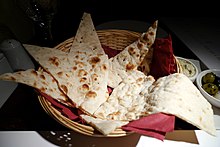拉瓦什
外观
(重定向自亞美尼亞脆餅)
 | |
| 类型 | 薄餅 |
|---|---|
| 起源地 | 亞美尼亞[1][2][3][4][5] / 伊朗[6][7][8] |
| 地区 | 西亞 |
| 上菜温度 | 冷、熱 |
| 拉瓦什,傳統麵包的製作、意義和外觀,作為亞美尼亞文化的展現 * | |
|---|---|
 Lavash making in Armenia | |
| 国家 | 亞美尼亞 |
| 参考自 | 985 |
| 地区 ** | 歐洲和北美地區 |
| 入册历史 | |
| 入册历史 | 2014年(第9th屆會議) |
| * 根据联合国教科文组织的命名 ** 根据联合国教科文组织的分类地区 | |
| 薄餅製作和分享文化:拉瓦什、卡提爾瑪、尤普卡、尤福卡 * * | |
|---|---|
 | |
| 参考自 | 1181 |
| 地区 ** | 歐洲和北美地區 |
| 入册历史 | |
| 入册历史 | 2016年(第11th屆會議) |
| * 根据联合国教科文组织的命名 ** 根据联合国教科文组织的分类地区 | |

拉瓦什[9](亞美尼亞語:լավաշ,波斯語:نان لواش)又稱亞美尼亞薄餅、亞美尼亞脆餅,是南高加索、西亚和裏海周边地区的亞美尼亞、阿塞拜疆、伊朗和土耳其境內常见的一種面饼[10][11] ,在古代,亞美尼亞脆餅主要馕坑中烘烤。現在也有人在鑊中製作亞美尼亞脆餅[12][13][14][15]。2014年,亞美尼亞脆餅被列入联合国教科文组织非物质文化遗产名录和优秀保护实践名册 [16] 。
参考文献
[编辑]- ^ Lavash. The American Heritage Dictionary.
- ^ Sergio O. Serna-Saldivar. Cereal Grains: Laboratory Reference and Procedures Manual.. CRC Press. 2012: 217. ISBN 9781439855652.
Lavash is another popular flat cracker bread with ancient roots in Armenia.
- ^ Albala, Ken (编). Food Cultures of the World Encyclopedia, Volume 1. Santa Barbara, California: Greenwood Press. : 5. ISBN 9780313376269.
...on lavash, a traditional flatbread of Armenia similar to tortilla...
- ^ Goldstein, Darra. A Taste of Russia: A Cookbook of Russian Hospitality
 2nd. Montpelier, VT: Russian Life Books. 1999: 185. ISBN 9781880100424.
2nd. Montpelier, VT: Russian Life Books. 1999: 185. ISBN 9781880100424. Armenian Flat Bread Lavash: Lavash has been baked for centuries in Armenia.
- ^ Khanam, R. Encycl. Ethnography Of Middle-East And Central Asia (3 Vols. Set) 1st. New Delhi: Global Vision. 2005: 55. ISBN 9788182200623.
The t'onir is a round hole dug in the ground, which can be used for baking Armenian flat bread (lavash) and for heating the home in winter.
- ^ Karizaki, Vahid Mohammadpour. Ethnic and traditional Iranian breads: different types, and historical and cultural aspects. Journal of Ethnic Foods. 2017-03-01, 4 (1): 8–14. ISSN 2352-6181. doi:10.1016/j.jef.2017.01.002
 .
. The origin of lavash is most probably from Iran, according to the state of the encyclopedia of Jewish food.
- ^ Marks, Gil. Encyclopedia of Jewish Food. Houghton Mifflin Harcourt. 2010: 355. ISBN 978-0470391303.
- ^ Reinhart, Peter. The Bread Baker's Apprentice: Mastering the Art of Extraordinary Bread. Potter/TenSpeed/Harmony. 2011: 178. ISBN 978-1607741299.
Lavash, though usually called Armenian flatbread, also has Iranian roots (...)
- ^ 拉瓦什、卡提爾瑪、尤普卡、尤福卡:薄餅製作與分享的文化—文化部文化資產局
- ^ Kipfer, Barbara Ann. The Culinarian: A Kitchen Desk Reference. Houghton Mifflin Harcourt. 2012-04-11: 334 (2012) [2015-06-01]. ISBN 9780544186033.
LAVASH, LAVOSH, LAHVOSH, LAWAASH, or LAWASHA, also called ARMENIAN CRACKER BREAD, CRACKER BREAD, or PARAKI, is a round, thin Middle Eastern bread that is soft like a tortilla or hard like a cracker.
- ^ Tastes of Memory: How to Bake an Authentic Armenian Lavash. Smithsonian. [2023-11-10]. (原始内容存档于2016-04-10).
- ^ Alan Davidson. The Oxford Companion to Food. Oxford University Press. 1999: 456. ISBN 978-0192806819.
Lavash a thin crisp bread usually made with wheat flour made in a variety of shapes all over the regions of the South Caucasus, Iran (where it is often so thin as to be like tissue and can be almost seen through), and Afghanistan. It is leavened and baked in a tandoor. Lavash is served with kebabs and is used to scoop up food or wrap round food before being eaten. Its origins are ancient and it is also known as lavaş depending on the region. As in the other countries of this region large batches of this bread are made and stored for long periods. In Turkey they are stored on a board suspended by all four corners from the ceiling. The bread becomes dry and is restored by sprinkling with water and reheated as and when needed. Yufka is also a name for filo pastry.
- ^ Gil Marks. Encyclopedia of Jewish Food. John Wiley and Sons. 2010: 355.
- ^ Morgan, Diane. Skinny Dips. Chronicle Books. 2010: 14. ISBN 978-1452100241.
Lavash, lavosh, or lahvosh is a gigantic, paper-thin, blistery, tortilla-like flatbread common throughout Armenia, Turkey, and Iran.
- ^ Lavash. February 26, 2020 [2023-11-10]. (原始内容存档于2020-02-29).
- ^ Lavash, the preparation, meaning and appearance of traditional bread as an expression of culture in Armenia, Inscribed in 2014 (9.COM) on the Representative List of the Intangible Cultural Heritage of Humanity. Country(ies): Armenia. unesco.org. [16 March 2016]. (原始内容存档于2015-12-10).
